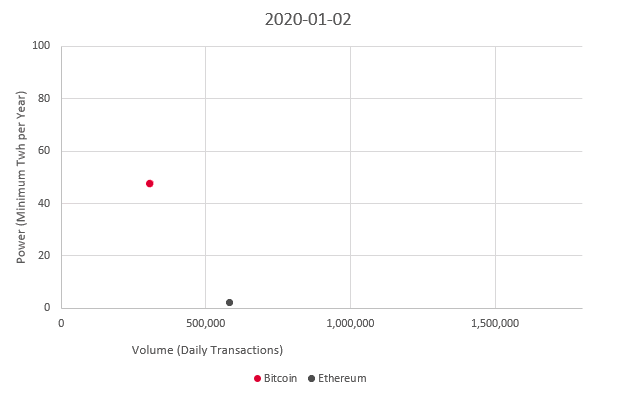Power usage and transaction volume over time

Power https://digiconomist.net/
ETH Volume https://etherscan.io/
BC Volume https://data.bitcoinity.org/
How can asset managers measure bitcoin value against energy cost?
The headlines keep coming about the stratospheric energy consumption of Bitcoin. It has now passed the annual energy consumption of certain countries including Sweden. For ESG focused asset managers and investors, are these statistics a deal breaker for crypto asset investing?
It is difficult to estimate the amount of power a crypto currency uses; however given that they are comparable to countries, all indications are that the power usage is enormous.
This chart compares the energy consumption of the two largest crypto currencies, Bitcoin and Etherum, against their daily transactions over time.
The number of transactions a digital currency, crypto or fiat, can support is a measure of the value this currency offers.
The numbers of daily transactions in these crypto currencies are 100s of times smaller than those completed by digital fiat. However as a distributed ledger the power usage of crypto currencies is higher than those of digital fiat.
An inefficient use of resources
While much of this energy is consumed by data centers that often use at least partially renewable power, it is clearly an inefficient use of resources from a global energy perspective. If viewed from an energy efficiency perspective, the value in terms of the number of transactions supported is very small compared with the power requirements.
It is not a good property of a currency or asset to require such significant power to maintain itself. Ethereum’s shift from proof of work to proof of stake in September 2022 goes a long way to changing this dynamic, reducing power requirements down by a factor of thousands.
Competing with digital fiat
Despite the vast improvements in Ethereum’s energy consumption, it still performs approximately 3 times worse than Mastercard transactions.
Without further technological shifts, crypto still cannot compete with digital fiat from an energy efficiency perspective. With results like this, ESG focused Institutional asset managers and retail investors are likely to pause when considering portfolios that include crypto asset investing.

Methodology
Data was not available for certain days. In these cases, the previous value is rolled forward.
The data points are provided for every 3rd day. The charted data used a 5 data point moving average to smooth the usage, as the data points are for every 3rd day this is a 15-day moving average.
With Environmental, Social, and Governance (ESG) factors on the global agenda asset managers and hedge funds recognize an important growth opportunity. At the same time, you face greater pressure from regulators and investors for better data, analysis, standards, and transparency. Linedata is committed to accelerating global sustainability by helping more asset managers drive new business and sustainability with easy and efficient access to credible ESG data and scoring in their portfolios.
Contact us to start a conversation today.
About the author, David Boot

David Boot is Global Product Manager for institutional asset management clients. He has 20 years experience in the industry bringing innovation and adaptability to clients’ toughest risk, data and analytics challenges.
More from Linedata

Having ESG scores available within your OMS or PMS, even in non-ESG portfolios, builds awareness of how small changes in...

A lack of standardization remains a challenge, as ESG ratings do diverge between evaluating organizations.

Learn how Linedata helped CRM reduce operating costs by 50% with significantly better service and results.



